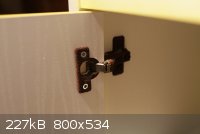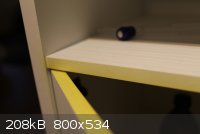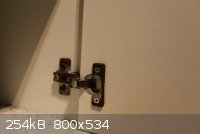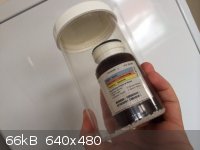oblivious_terpene
Harmless

Posts: 2
Registered: 22-12-2013
Member Is Offline
Mood: No Mood
|
|
interesting phenomena - what causes this corrosion/yellow staining? photos provided
Hey everyone,
Something has happened to my chemical storage cabinet. The cabinet shows a very visible discoloration, and the hinges has sustained heavy surface
corrosion. Not shown in the photos, is that the discoloration has also affected other containers of chemicals. A stack of papers that was stored in
the same cabinet has also been heavily stained yellow.
The following chemicals was contained within the cabinet. They've been stored here for atleast a year:
-Calcium carbide (tech. grade, not stored in air tight container).
-An airtight bottle of Dichloromethane
-2 small airtight bottles of Iodine crystals
-about 2 pounds of Hexamine, stored in a white PE bottle
-1 pound of sodium nitrite, stored in white PE bottle
- + small quantities of magnesium sulfate, sulfamic acid, sulfur powder, and for some reason, tartaric acid
I suspect the main culprit to be the carbide, as this was stored in a glass jar, and it looked like a large part of this carbide had reacted. I
remember when i placed the carbide in the glass jar, it consisted of pieces of clean carbide. When i recently inspected the jar, the carbide pieces
was covered by a fine dust/powder. I guess this means the carbide has reacted with moisture in the air, resulting in Ca(OH)2, and other
stuff from the technical grade carbide.
So what do you guys think? What has caused these yellow stains and corrosion?
Thanks for any answers, cheers
  
|
|
|
bfesser
Resident Wikipedian
    
Posts: 2114
Registered: 29-1-2008
Member Is Offline
Mood: No Mood
|
|
Looks like iodine staining to me. 'Airtight' often doesn't correlate to iodine-tight. The only
way I've been able to satisfactorily contain it at room temperature is inside sealed glass ampoules. Even proper high quality PTFE/silicone lined
phenolic capped glass bottles with a generous wrapping of Parafilm over the closures were hopeless.
Welcome to ScienceMadness!
[Edited on 22.12.13 by bfesser]
|
|
|
Nickdul
Hazard to Self
 
Posts: 96
Registered: 13-2-2012
Location: Bulgaria
Member Is Offline
Mood: No Mood
|
|
I'd say if it wasn't for those terribly corroded hinges that you got a pretty fashionable cabinet now 
Looks a lot more like iodine damage to me, even stoppered teflon-lipped bottles have caused such rusting for me. If you have some sodium thiosulfate,
you could try applying a solution to the stains and see if the discoloration goes away. I can't see how carbide, reacted or not could cause such
staining (am I right in assuming only the edgings show a distinct, uniform stain)
Storing the iodine in a two ziplock bags has taken care of the problem for me. Clean up the hinges with SS wool and lacquer them with some thinned
polyurethane varnish, or one of those varnishes in a spray can. They should be good for some time. 
|
|
|
Mailinmypocket
International Hazard
    
Posts: 1351
Registered: 12-5-2011
Member Is Offline
Mood: No Mood
|
|
Just a trick for iodine... I keep the jar (Teflon lined cap and Teflon taped) inside a bigger jar with a layer of solid sodium thiosulfate on the
bottom. After always smelling hints of iodine after my attempts at sealing the jar I tried that and it works perfectly. Don't get me wrong, iodine
smells awesome but the damage it does is annoying
|
|
|
blogfast25
International Hazard
    
Posts: 10562
Registered: 3-2-2008
Location: Neverland
Member Is Offline
Mood: No Mood
|
|
Yes, it's iodine staining. Very hard to contain properly is iodine...
|
|
|
plante1999
International Hazard
    
Posts: 1936
Registered: 27-12-2010
Member Is Offline
Mood: Mad as a hatter
|
|
Just a tip, buy some viton rubber sheet on ebay, and make a lining of it. when the cap is well closed, it only leek sligthly.
I never asked for this.
|
|
|
oblivious_terpene
Harmless

Posts: 2
Registered: 22-12-2013
Member Is Offline
Mood: No Mood
|
|
I'm certainly surprised that iodine caused this, but ofcourse it makes sense. For now, I'll put the iodine in a 24/40 250 ml bottle, and stretch some
teflon tape around the stopper before I seal it off. I'll place it in a small cabinet, and I'll check tomorrow if I can smell the iodine.
If I do, I'll check back here for the more thorough solutions provided by your kind replies.
thanks everyone!
|
|
|
Mailinmypocket
International Hazard
    
Posts: 1351
Registered: 12-5-2011
Member Is Offline
Mood: No Mood
|
|
Eye oh dine!
The thiosulfate trick works like a charm. No need to buy special stuff. Notice the color of the inside of the lid on the secondary container?! Had to
do this after my order arrived and my other half wouldn't stop complaining of the "medicine" smell 
Just a table spoon of thiosulfate works nicely.

|
|
|
mkurek
Harmless

Posts: 8
Registered: 23-12-2013
Member Is Offline
Mood: No Mood
|
|
Quote: Originally posted by Mailinmypocket  | Eye oh dine!
The thiosulfate trick works like a charm. No need to buy special stuff. Notice the color of the inside of the lid on the secondary container?! Had to
do this after my order arrived and my other half wouldn't stop complaining of the "medicine" smell 
Just a table spoon of thiosulfate works nicely.
|
I'll have to try the thiosulfate trick in my lab. I've never found a way to stop the iodine smell
|
|
|